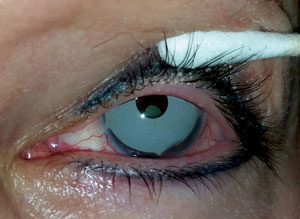|
|

|
Q: My patient said she heard about iris implants to change her eye color. Have you seen a patient who has had them, and are there any complications?
A: For quite some time, people have been seeking ways to change their eye color. The most common method is through colored contact lenses. Yet, some people have sought more permanent solutions.
“Currently, there is no way approved by the FDA to permanently change the color of the iris,” says corneal surgeon Rishi Parikh, MD, of Omni Eye Services, in Atlanta. “However, other countries offer a cosmetic, implantable iris prosthesis that can change the perceived color of the eyes.” So, some patients will get on a plane to have this done.
These silicone prosthetic devices are inserted into the anterior chamber of the eye and essentially sit on the iris. “Unfortunately, the implants are not secured in any way, so they can ‘bounce’ around and cause multiple complications,” Dr. Parikh says.
Potential complications include endothelial cell loss and subsequent corneal edema, elevated intraocular pressure from damage to the trabecular meshwork and angle structures leading to glaucoma, chronic anterior chamber inflammation, anterior and posterior synechia, cataract formation, and decreased visual acuity.1

|
|
| Iris implants, which are not approved by the FDA, can cause corneal edema, decreased visual acuity, cataracts and anterior and posterior synechiae—just to name a few complications. |
Because of these significant dangers, our professional organizations strongly discourage implantation of these devices, and doctors should recommend immediate removal if they have already been implanted in a patient, Dr. Parikh says.2
He has seen these problems in his own practice. Currently, Dr. Parikh is managing a 48-year-old female patient who presented with gradual decrease in vision in both eyes over the last several years. The patient lives in the United States, but after finding no American surgeon who would do the procedure, she flew to Istanbul in 2011 to have the iris prostheses implanted.
When Dr. Parikh first evaluated the patient, her vision was 20/400 in both eyes. She had severe corneal edema with bullae on both corneas. Both eyes showed multiple areas of peripheral anterior synechia. The iris implants were visible, though somewhat obscuring both pupils. Severe posterior synchiae caused both pupils to be fixed. Dense, 3 to 4+ nuclear sclerotic cataracts were visible in both eyes. Endothelial cell counts were greatly reduced and pachymetries were elevated, although her intraocular pressures were within normal limits.
“I attempted iris prosthesis removal, posterior synechialysis and cataract extraction in the right eye, which was successful,” Dr. Parikh says. “However, it has now been two weeks since the surgery and her cornea remains extremely edematous. If it does not resolve—and at this point I don’t expect it to—I’ll likely have to do a DSAEK [Descemet’s stripping automated endothelial keratoplasty] corneal transplant on this eye. If this ends up being successful, I’ll assume her left eye will behave similarly, so I’ll likely do a combined cataract extraction and DSAEK corneal transplant on the left eye.”
After all these surgeries, he hopes to restore her vision to 20/30 in both eyes.
“It’s a great example of an unnecessary cosmetic procedure severely debilitating a patient and producing a great burden on the medical health care system to repair the damage,” Dr. Parikh says. “And she’s lucky it can be repaired—there are many people who may have permanent vision loss.”
1. Hoguet A, Ritterband D, Koplin R, et al. Serious ocular complications of cosmetic iris implants in 14 eyes. J Cataract Refract Surg. 2012 Mar;38(3):387-93.2. AAO.org website. Press release: American Academy of Ophthalmology Issues Warning About Iris Implant Surgery to Change Eye Color. Oct 31, 2014, Available at: www.aao.org/newsroom/release/iris-implant-surgery-warning.cfm.

